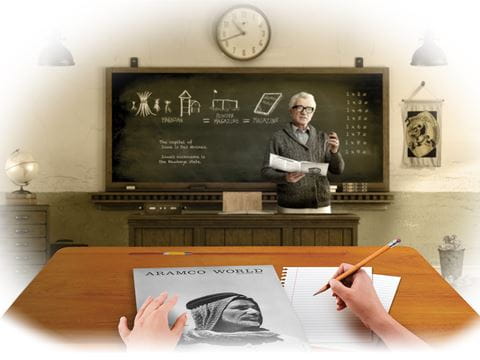
Defining the Purpose of Art
Art
Americas
For teachers: We encourage reproduction and adaptation of these ideas, freely and without further permission from AramcoWorld, by teachers at any level.
Common Core Standards met in this lesson: RL/RI.1, SL.9-10.1, W.2 (see details below).
—The Editors
Do you have comments? I'd be pleased to hear from you at [email protected].
—Julie Weiss
Ambassadors of Art: The What and Why of Art
What is art? Why do people create it? There are probably as many answers to these questions as there are artists and art esthetics. "Ambassadors of Art" focuses on the work of Saudi Arabian artists, on its recent series of exhibitions in cities across the United States, and on the perspectives of artists and viewers about what art means and why it's displayed. As you follow the activities below, reflect on these issues for yourself. By the time you finish, you will be able to:
•Explain how various artists understand the purpose of their art.
•React to and analyze works of art.
•Assess the extent to which works of art affect you as artists intend.
•Generate your own definition of the purposes of art?
What is art? What functions does it serve?
What is art? Without thinking too hard about it, write down an answer. Even if you've never thought consciously about it or put words to it, you probably have some definition of art floating in your mind. Don't worry--you're only revealing them to yourself. You don't need to share what you've written, unless you want to.
As you might have guessed, plenty of people have given a lot of thought to the question of what art is. In "Ambassadors of Art," artists, professors, museum curators and museum visitors offer their definitions of art and what functions it serves in society. Read the article, and as you do, take note of their statements. You can do this by underlining or highlighting them, or writing them down on a sheet of paper. When you're done, team up with another student and read through the parts of the article that you've noted. On a sheet of paper write, "Art is ... ." Then, make a bulleted list of the different definitions of art? Write a few sentences about how the article's definitions and yours are similar and different, and what you think might account for those comparisons.
It's worth noting, too, what's not in the definitions of art expressed in "Ambassadors of Art." Only a videographer and a student viewer of the exhibition of Saudi art used the word "beautiful" to describe art. Is beauty part of how you think of art? Why do you think it's not mentioned more in the article?
Appreciating and Analyzing Works of Art
Turn your attention from the somewhat abstract task of defining art to the more concrete act of seeing and hearing art. With a partner choose one of these works of art shown in the article:
- "Tree of Guardians"
- "Heaven's Doors"
- "Street Pulse"
- "Never Never Land" or
- "Paradise Has Many Gates"
How Do Works of Art Compare to Definitions of Art?
So far, you've read and thought about different definitions of art and you've reacted to and analyzed a work of art. Now it's time to bring the two together. With your partner, look at your list of definitions of art and consider the specific work of art you've focused on. How do they match up? In other words, do you see the work of art as an example of one or more of the definitions of art? If you imagine the work of art displayed in a museum (as it has been), does it fit one of your definitions of art? If so, discuss with your partner how it fits. If not, discuss why you think it doesn't. Then share together with other pairs in the class, listening to the analysis of work of art of others and their thoughts about how the work and its display do or do not seem to match the definitions you have read.
Upon the completion of these activities, write your own statement answering these questions:
- What is your definition of art?
- What do you think are the purposes of creating and displaying art?
Common Core Standards met in this lesson:
RL/RI.1 Read closely to determine what the text says explicitly and to make logical inferences from it; cite specific textual evidence when writing or speaking to support conclusions drawn from the text.
RI.9-10.1 Initiate and participate effectively in a range of collaborative discussions (one one one, in groups and teach led) with diverse partners on grades 9-10 topics, texts and issues, building on others' ideas and expressing their own clearly and persuasively.
W.2 Write informative/explanatory texts to examine and convey complex ideas and information clearly and accurately through the effective selection, organization and analysis of content.
Other lessons

Teaching Empathy: Five Classroom Activities From AramcoWorld
For the Teacher's Desk
Help students build empathy and community for the academic year with AramcoWorld’s stories and Learning Center lessons.
How Art Connects
For the Teacher's Desk
Art links everything—cultures, history, even math. Want to hook students? Try teaching through the art that surrounds us with these stories.
Breaking Bread: Using Food As a Teaching Tool
For the Teacher's Desk
Using food as a teaching tool, students widen their global understanding of other cultures while deepening their connection to the world.